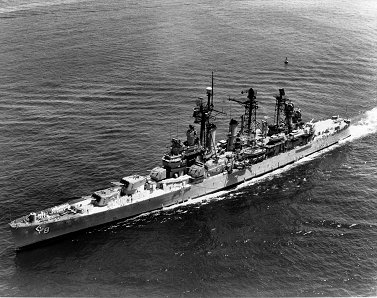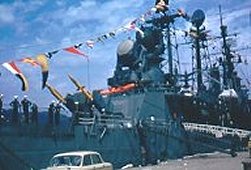 |
|
USS Topeka CLG 8
Photo Submitted by Dudley Cass |
Re-designated CLG 8 -- 1957
Early in 1957, Topeka was towed from San Francisco to the New York Naval
Shipyard that she entered on 15 April to begin conversion to a guided
missile cruiser. On 23 May, she was officially re-designated, CLG 8.
During the almost three years it took to convert her, the cruiser was
extensively modified. She retained only half her original gun battery,
losing her two after 6-inch triple turrets and her three after 5-inch
double mounts. The removal of those guns made room for the installation of
her twin Terrier surface-to-air missile launcher and related ancillary
equipment.
Re-commissioned -- 1960
On 26 March 1960, Topeka was re-commissioned, Capt. Frank L. Pinney, Jr.,
in command. In July, she made the passage from New York to the west coast.
From August to October, the refurbished cruiser conducted shakedown
training in the southern California operating area and then reported for
duty at her home port, Long Beach. During the ensuing three years, Topeka
alternated two peacetime deployments to the western Pacific with repair
periods and local operations on the west coast. Her two tours in the
Orient were characterized by visits to such places as Hong Kong, the
Philippines, Okinawa, and a number of ports in Japan as well as exercises
with other ships of the 7th Fleet and of Allied navies. When not deployed
to the Far East, she conducted training operations, upkeep, and repairs.
 |
 |
|
Typhoon 1961
Photo by Ken Noble
|
Open House in Nagasaki 1961
Photo by Ken Noble |
Gulf of Tonkin -- 1964
In March 1964, she embarked upon her third deployment to the western
Pacific since being re-commissioned. That deployment began routinely
enough with fleet exercises in May and calls at Japanese, Taiwanese,
Malaysian, and Philippine ports. However, in August, North Vietnamese
torpedo-boats attacked Maddox (DD 731) on the 2d and then returned
to attack Maddox and Turner Joy (DD 951). This action —
known as the Gulf of Tonkin incident — gave the remaining part of
Topeka’s deployment a more wartime character. Topeka cruised
the waters of the Gulf of Tonkin while American involvement in the Vietnam
conflict began to gather a momentum. It was more than a year, though,
before she steamed into war in earnest. Late in October, she started for
home and reentered Long Beach near the end of the second week of November.
For the next 12 months, she viewed the developing war from afar —
operating out of west coast ports, undergoing repairs and modifications,
and conducting exercises with the 1st Fleet.
On 29 November 1965, however, she headed back to the western pacific
for the first deployment during which her primary mission was to support
the American and South Vietnamese forces fighting the communists. On that
tour of duty, she served as the flagship for the Commander,
Cruiser-Destroyer Group, 7th Fleet. In that capacity, the ship operated in
the South China Sea and in the Gulf of Tonkin providing naval gunfire
support for the troops ashore and supporting carrier air operations by
conducting search and rescue missions for downed air crews. She punctuated
tours of duty in the combat zone with port visits to Yokosuka, Japan; Hong
Kong; and the Philippine ports of Manila and Subic Bay. Her six-month
deployment ended on 28 May 1966 when Topeka reentered Long Beach.
Mediterranean Sea Deployment
Five months of normal west coast operations — upkeep, training exercises,
and the like — followed. On 31 October 1966, the guided missile cruiser
entered Hunter's Point Naval Shipyard in San Francisco
for an overhaul during which her weapons systems were
updated; and her engineering plant was overhauled. On 13 March 1967, she
completed the yard overhaul and began sea trials and, later, refresher
training. She finished those evolution’s early in June and resumed local
operations. On 1 August, the warship put to sea from Long Beach for her
first deployment to the Mediterranean Sea. She stopped at Norfolk on 12
and 13 August to embark the Commander, Cruiser-Destroyer Flotilla 12, and
his staff and then sailed for Palm de Majorca on the 14th. On the 20th,
Topeka joined the 6th Fleet and, on the 22d, relieved Galveston
(CLG 3) as flagship for TG 60.2. During her five months with the 6th
Fleet, she ranged the length of the "middle sea." In late September and
early October, the warship participated in NATO exercise "Eager Beaver,"
conducted in the eastern end of the Mediterranean. In mid-October,
she-conducted operations in the Ionian and Tyrrhenian Seas on her way back
to the western end.
 |
|
Topeka in The Grand Harbor Malta in 1968
Photo taken and submitted by Brian Whitehead - Royal Air Force
For a larger image
click here |
In January 1968, she concluded her first tour of duty in the
Mediterranean with another NATO exercise -- this one an amphibious
operation. On the 12th, she was relieved by Columbus (CG 12) at
Rota, Spain. The cruiser then headed back to the United States. After
stops at Puerto Rico and in the Canal Zone, Topeka reentered Long
Beach on 29 January.
On 2 February, the warship began a five-week availability at the Long
Beach Naval Shipyard. The guided-missile cruiser departed Long Beach again
on 15 March, bound for her new home port, Mayport, Fla. After arriving at
her destination on 21 March, Topeka remained in port for upkeep
until 6 May when she returned to sea for refresher training at Guantanamo
Bay, Cuba. Returning to Mayport on the 26th, the ship began preparations
for another deployment to the Mediterranean — the last deployment of her
career.
Final Deployment
Topeka departed Mayport on 29 June and, after gunnery exercises at Culebra
Island near Puerto Rico, she headed across the Atlantic. On 9
July, she relieved Columbus at Malaga, Spain, and began 6th Fleet
operations. The warship’s final deployment proved to be routine in nature.
She visited ports all along the Mediterranean littoral and conducted
operations in all portions of the middle sea from the Aegean and Ionian
Seas in the east to the Riviera ports in the west. Spain, Italy, Greece,
Turkey, and France — as well as the islands of Malta, Crete, and Majorca —
provided her with interesting ports of call. Topeka concluded her
assignment with the 6th Fleet on 9 December at Rota when she was relieved
once again by Columbus. That same day, she headed for Mayport,
arriving 10 days later.
On 30 January 1969, Topeka steamed out of May-port and proceeded
north for inactivation. After a stop at Yorktown, Va., to off-load her
ordnance, she arrived in Boston on 5 February. There, she completed
inactivation preparations; and, on 5 June, Topeka was placed out of
commission. The warship was towed to Philadelphia and was berthed with the
reserve fleet group there. On 1 December 1973, her name was struck from
the Navy list; and, on 20 March 1975, she was sold to the Southern Scrap
Material Co., Ltd., for scrapping.
Topeka was awarded two battle stars for her World War II service
and three battle stars for her Vietnam service.




